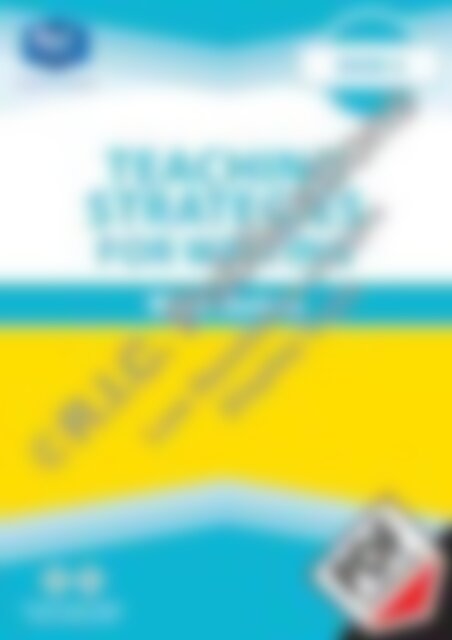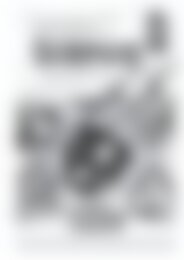RIC-20786_Teaching_Strategies_for_Writing_BkA_word_choices
Create successful ePaper yourself
Turn your PDF publications into a flip-book with our unique Google optimized e-Paper software.
Your partner in education<br />
BOOK A<br />
TEACHING<br />
STRATEGIES<br />
FOR WRITING<br />
Word <strong>choices</strong><br />
Australian Primary Publisher<br />
of the Year 2015 and 2016
<strong>Teaching</strong> strategies <strong>for</strong> writing (Book A)<br />
Published by R.I.C. Publications ® 2018<br />
Copyright © Diane Henderson and Rosemary Morris 2018<br />
<strong>RIC</strong>–<strong>20786</strong><br />
Titles in this series:<br />
<strong>Teaching</strong> strategies <strong>for</strong> writing (Book A)<br />
<strong>Teaching</strong> strategies <strong>for</strong> writing (Book B)<br />
<strong>Teaching</strong> strategies <strong>for</strong> writing (Book C)<br />
<strong>Teaching</strong> strategies <strong>for</strong> writing (Book D)<br />
<strong>Teaching</strong> strategies <strong>for</strong> writing (Book E)<br />
<strong>Teaching</strong> strategies <strong>for</strong> writing (Book F)<br />
Copyright Notice<br />
A number of pages in this book are worksheets.<br />
The publisher licenses the individual teacher<br />
who purchased this book to photocopy these<br />
pages to hand out to students in their own<br />
classes.<br />
Except as allowed under the Copyright Act 1968,<br />
any other use (including digital and online uses<br />
and the creation of overhead transparencies<br />
or posters) or any use by or <strong>for</strong> other people<br />
(including by or <strong>for</strong> other teachers, students or<br />
institutions) is prohibited. If you want a licence<br />
to do anything outside the scope of the BLM<br />
licence above, please contact the Publisher.<br />
This in<strong>for</strong>mation is provided to clarify the limits<br />
of this licence and its interaction with the<br />
Copyright Act.<br />
For your added protection in the case of<br />
copyright inspection, please complete the <strong>for</strong>m<br />
below. Retain this <strong>for</strong>m, the complete original<br />
document and the invoice or receipt as proof<br />
of purchase.<br />
Name of Purchaser:<br />
Date of Purchase:<br />
Supplier:<br />
School Order# (if applicable):<br />
Signature of Purchaser:<br />
Internet websites<br />
In some instances, websites or specific URLs may be recommended. While these are checked and rechecked at the time of<br />
publication, the publisher has no control over any subsequent changes which may be made to webpages. It is strongly recommended<br />
that the class teacher checks all URLs be<strong>for</strong>e allowing students to access them.<br />
View all pages online<br />
PO Box 332 Greenwood Western Australia 6924<br />
Website: www.ricpublications.com.au<br />
Email: mail@ricpublications.com.au<br />
2015 & 2016
FOREWORD<br />
<strong>Teaching</strong> strategies <strong>for</strong> writing is series of six books using modelling, guided and independent practice to teach<br />
students strategies they can use to improve the clarity, correctness and richness of their writing. The focus is on<br />
sentences, their structure, punctuation and <strong>word</strong> <strong>choices</strong> and on developing editing and proofreading skills and their<br />
habitual use.<br />
Titles in this series:<br />
• <strong>Teaching</strong> strategies <strong>for</strong> writing (Book A) • <strong>Teaching</strong> strategies <strong>for</strong> writing (Book D)<br />
• <strong>Teaching</strong> strategies <strong>for</strong> writing (Book B) • <strong>Teaching</strong> strategies <strong>for</strong> writing (Book E)<br />
• <strong>Teaching</strong> strategies <strong>for</strong> writing (Book C) • <strong>Teaching</strong> strategies <strong>for</strong> writing (Book F)<br />
TABLE OF CONTENTS<br />
Teachers notes ................................................................................................... iv–v<br />
Class recording sheets<br />
Assessment activities ................................................................................... vi–ix<br />
Assessment writing ........................................................................................ x–xi<br />
Student writing checklist ...................................................................................... xii<br />
Student self-evaluation ....................................................................................... xiii<br />
WORD CHOICES<br />
Unit 1 Nouns, noun groups and adjectives ............................................... 2–7<br />
Unit 2 Pronouns, confusing pronouns (me, I), which pronoun? ............... 8–13<br />
Unit 3 Verbs and adverbials .................................................................... 14–19<br />
Unit 4 Verbs: tense, matching verbs ...................................................... 20–25<br />
Assessment ................................................................................................ 26–29<br />
SENTENCE STRUCTURE<br />
Unit 5 Sentences, <strong>word</strong> order, questions ............................................... 30–35<br />
Unit 6 Sentence beginnings ................................................................... 36–41<br />
Unit 7 Conjunctions ................................................................................ 42–47<br />
Unit 8 Paragraphs ................................................................................... 48–53<br />
Assessment ................................................................................................ 54–57<br />
PUNCTUATION<br />
Unit 9 Using punctuation, short sentences ........................................... 58–63<br />
Unit 10 Full stops, capital letters, proper nouns and commands ............ 64–69<br />
Unit 11 Apostrophes in contractions ....................................................... 70–75<br />
Unit 12 Apostrophes <strong>for</strong> possession ........................................................ 76–81<br />
Assessment ................................................................................................ 82–85<br />
EDITING AND PROOFREADING<br />
Unit 13<br />
Unit 14<br />
Unit 15<br />
Unit 16<br />
Spelling (vowel sounds), sentence structure,<br />
punctuation, <strong>word</strong> <strong>choices</strong>, editing ............................................ 86–91<br />
Spelling (more vowel sounds), sentence structure,<br />
punctuation, <strong>word</strong> <strong>choices</strong>, editing ............................................. 92–97<br />
Spelling (suffixes) sentence structure,<br />
punctuation, <strong>word</strong> <strong>choices</strong>, editing ........................................... 98–103<br />
Spelling (homophones), sentence structure,<br />
punctuation, <strong>word</strong> <strong>choices</strong>, editing ......................................... 104–109<br />
Assessment ............................................................................................ 110–113<br />
TEACHING STRATEGIES FOR WRITING (Book A)<br />
www.ricpublications.com.au<br />
iii
TEACHER NOTES<br />
ABOUT WRITING<br />
A good writer is not simply one who knows about and can<br />
use text types. A good writer is one with the capacity to<br />
produce interesting, in<strong>for</strong>mative, grammatically correct<br />
text, <strong>for</strong> a specific purpose, that achieves any writer’s<br />
intent – clear, precise communication.<br />
TEACHING WRITING<br />
Students can and should be taught strategies that will<br />
help them to write better. These include improvements<br />
in <strong>word</strong> <strong>choices</strong>, sentence structure, punctuation and<br />
editing and proofreading. <strong>Writing</strong> strategies taught<br />
should be modelled, discussed and then applied, firstly<br />
with teacher support and then independently. However,<br />
the emphasis always should be on the writing process,<br />
which requires <strong>for</strong>ethought, planning and a rational,<br />
measured approach in order to produce the desired<br />
outcome. Editing and proofreading are essential<br />
components of any writing. It is important that students<br />
edit and proofread habitually, with a specific purpose,<br />
and concentrate on the careful consideration of each<br />
sentence, one at a time. Activities provided in this series<br />
encourage students to think about appropriate aspects<br />
of their writing be<strong>for</strong>e, during and after the process.<br />
LESSON PROCEDURE<br />
Introduction<br />
Discuss the text title with students. Ask <strong>for</strong> their<br />
interpretations of what the title could mean.<br />
Discuss the text type. Why does it fit into this category?<br />
What are the specific features of this type of text?<br />
Guide the discussion to introduce the teaching points/<br />
strategies to be covered during the course of the unit.<br />
For example, check they understand terms such as noun<br />
group, adverbial, sentence, paragraph and comma.<br />
Development<br />
Read and discuss the text, either in groups or as a<br />
class. Assist students with any unfamiliar vocabulary or<br />
expressions.<br />
Differentiation<br />
Work through the introductory activities with the class<br />
as a whole, ensuring students understand what is<br />
required of them.<br />
Work with those requiring additional assistance while<br />
the remainder of the class work independently on the<br />
activities.<br />
ASSESSMENT<br />
An assessment is included <strong>for</strong> each unit in the book.<br />
Because of the way it is structured, this assessment<br />
will allow you to see individual student’s understandings<br />
as well as any common points of weakness which may<br />
require further assistance.<br />
FORMAT<br />
<strong>Teaching</strong> strategies <strong>for</strong> writing is organised into four<br />
sections:<br />
Word <strong>choices</strong><br />
Punctuation<br />
Sentence structure<br />
Editing and proofreading<br />
Each section has four units of work and one assessment<br />
unit.<br />
<strong>Teaching</strong> units<br />
Each six-page unit of work has a specific focus, two<br />
teacher pages and four activity pages.<br />
Assessment units<br />
• Following each section is a four-page unit of<br />
assessment activities—one page <strong>for</strong> each unit.<br />
• Answers are provided in the teachers pages <strong>for</strong> that<br />
unit.<br />
• Teacher record sheets—see pages vi–ix.<br />
Assessment writing tasks<br />
• A suggested paragraph writing topic <strong>for</strong> each unit is<br />
provided on the teachers pages.<br />
• Teacher recording sheet—see pages x–xi.<br />
• Student proofreading checklist—see page xii.<br />
• Student self-evaluation—see page xiii.<br />
Review<br />
In pairs or small groups, students review their answers,<br />
giving their reasoning where required and critiquing the<br />
longer sentence or paragraph responses.<br />
iv<br />
TEACHING STRATEGIES FOR WRITING (Book A)<br />
www.ricpublications.com.au
TEACHING STRATEGIES FOR WRITING (Book A)<br />
www.ricpublications.com.au<br />
TEACHING STRATEGIES FOR WRITING (Book A)<br />
www.ricpublications.com.au<br />
TEACHING STRATEGIES FOR WRITING (Book A)<br />
www.ricpublications.com.au<br />
978-1-925698-35-0<br />
978-1-925698-35-0<br />
978-1-925698-35-0<br />
TEACHING STRATEGIES FOR WRITING (Book A)<br />
www.ricpublications.com.au<br />
TEACHING STRATEGIES FOR WRITING (Book A)<br />
www.ricpublications.com.au<br />
TEACHING STRATEGIES FOR WRITING (Book A)<br />
www.ricpublications.com.au<br />
TEACHER NOTES<br />
Sample open pages<br />
TEACHER INFORMATION<br />
TEACHER INFORMATION<br />
UNIT 2<br />
PRONOUNS, CONFUSING PRONOUNS<br />
(ME/I), WHICH PRONOUN?<br />
UNIT 2<br />
PRONOUNS, CONFUSING PRONOUNS<br />
(ME/I), WHICH PRONOUN?<br />
Focus<br />
Word <strong>choices</strong> – pronouns, confusing pronouns (me, I), which<br />
pronoun?<br />
Progression<br />
Recognise<br />
Students will recognise a pronoun from modelled examples.<br />
Choose<br />
Students will choose appropriate pronouns from given examples,<br />
with teacher support.<br />
Use<br />
Students will choose and use correct and appropriate pronouns in<br />
supplied and self-written sentences.<br />
Definition of terms<br />
Pronouns are <strong>word</strong>s used to replace nouns.<br />
A possessive pronoun replaces a noun identifying ownership by<br />
the person or thing to which it refers.<br />
The subject of a verb is the person or thing ‘doing’ the action.<br />
The object of a verb is the person or thing affected by the action.<br />
Introduction<br />
Good writers improve their writing by replacing nouns with<br />
appropriate and correct pronouns.<br />
The use of pronouns prevents constant repetition of a noun,<br />
making text more manageable and fluid.<br />
It is important <strong>for</strong> students to know the correct pronouns to use in<br />
the context of a sentence.<br />
Possessive pronouns<br />
Possessive pronouns are used to replace the name of a person or<br />
thing; e.g. That book belongs to him (John), it is his.<br />
NOTE: The <strong>word</strong>s ‘his’ and ‘its’ can be used as a possessive<br />
determiner as well as a possessive pronoun; e.g. his book, its tail<br />
Relative pronouns<br />
The relative pronouns ‘who’,‘which’ and ‘that’ are used to refer to<br />
nouns and pronouns; e.g., the boy who, he who, the team that, the<br />
book which.<br />
The correct use of ‘who’ <strong>for</strong> people is more critical. Although<br />
‘which’ and ‘that’ can both be used in many contexts, ‘which’ should<br />
strictly be used to refer to a particular desk (telling which one);<br />
e.g. the desk which is by the door. The relative pronoun ‘that’ has<br />
a broader reference and doesn’t refer to one desk; e.g. the desks<br />
that are by the door.<br />
LESSON NOTES AND PLANS<br />
Introduction<br />
• Discuss the text title with students.<br />
• What sort of text do they think it will be?<br />
• Why do they think this? What are some of the features of a recount?<br />
• Introduce the term ‘pronoun’ and explain that <strong>word</strong>s replacing nouns<br />
are pronouns. Use examples from the classroom; e.g. Tran = he,<br />
Mary = she, the board = it, the tallest boy in the class = he.<br />
• Read the text with or to the class.<br />
• Identify some of the pronouns used in the text to replace people,<br />
places and things.<br />
• Identify single and plural pronouns from the text.<br />
Pronouns – Page 11<br />
• Read and discuss the definition at the top of the page.<br />
• Explain that good writers use pronouns instead of repeating the<br />
same nouns.<br />
• Explain why it is important to use the correct pronoun <strong>for</strong> the noun it<br />
replaces.<br />
• Work through the activities with the class as a whole, ensuring they<br />
understand what is required of them.<br />
• Work with those requiring additional assistance while the remainder<br />
of the class work independently on the activities.<br />
Using pronouns – Page 12<br />
• Discuss the examples at the top of the page.<br />
• Work through the activities with the class as a whole, ensuring they<br />
understand what is required of them.<br />
• Work with those requiring additional assistance while the remainder<br />
of the class work independently on the activities.<br />
• Provide opportunities <strong>for</strong> the class to share their answers to<br />
Question 2.<br />
Which pronoun – who or that? me or I? – Page 13<br />
• Questions 1 and 2 focus on the relative pronouns ‘who’ and ‘that’.<br />
• Explain that ‘who’ must be used <strong>for</strong> people.<br />
NOTE: ‘That’ and ‘which’ refer to things, places and can both be used<br />
<strong>for</strong> groups of people; e.g. the team which, a class that, (but ‘the<br />
members of the team who’).<br />
• Encourage students to read the sentences aloud to help them to<br />
choose the correct pronouns. Encourage them to ask the question<br />
‘Who did it?’; if the answer is ‘I’, then ‘I’ is correct; if not, it should be<br />
‘me’.<br />
ANSWERS<br />
Pronouns – Page 11<br />
1. (a) It<br />
(b) He<br />
(c) She<br />
2. (a) they<br />
(b) it<br />
(c) she<br />
3. (a) her<br />
(b) them<br />
(c) me<br />
4. (a) you<br />
(b) me, her, him, us<br />
(c) they<br />
Using pronouns – Page 12<br />
1. (a) No because the nouns are repeated and not replaced by<br />
pronouns<br />
(b) The girl and boy rode bikes to the zoo. They left them at the<br />
gate. The girl went to see the bears. She liked them. They were<br />
brown. The boy went to the penguins. He watched them playing<br />
in the water.<br />
2. (a) mine<br />
(b) ours<br />
(c) yours<br />
(d) theirs<br />
3. Teacher check<br />
Which pronoun – who or that? me or I?— Page 13<br />
1. (a) that<br />
(b) who<br />
2. Teacher check<br />
3. (a) me<br />
(b) I<br />
(c) me<br />
4. (a) ✗<br />
(b) ✓<br />
ASSESSMENT ANSWERS<br />
Assessment activity – Page 27<br />
1. (a) it<br />
(b) he<br />
2. (a) it<br />
(b) them<br />
3. (a) who<br />
(b) that<br />
4. (a) me<br />
(b) I<br />
5. The children went to the zoo. They enjoyed seeing the animals. My<br />
favourite was the giraffe. It was very tall.<br />
Class record sheet – Page vi<br />
ASSESSMENT WRITING<br />
• Paragraph topic – At the zoo<br />
• Focus: Word <strong>choices</strong> – pronouns<br />
Self-evaluation – Page xiii<br />
8 978-1-925698-35-0<br />
9<br />
Teacher page 1 Teacher page 2<br />
UNIT 2<br />
ZOO FRIENDS<br />
UNIT 2<br />
PRONOUNS<br />
A pronoun is used to replace a noun.<br />
For example:‘birds’ – they; ‘a frog’ – it<br />
1. Circle the pronouns in the sentences.<br />
(a) Sally saw a green snake. It was sleeping.<br />
Sally, Mike and Ellie went to the zoo.<br />
They all saw their favourite animals.<br />
Sally liked snakes. She saw a big green<br />
snake. It was sleeping. She saw two brown<br />
snakes. They were lying in the warm sun. One<br />
snake slid over to the glass. It flicked its<br />
tongue in and out. Sally thought it was<br />
smiling at her. She liked them all.<br />
The monkeys were Mike’s favourites.<br />
One monkey was eating melon. He<br />
had melon juice running down his<br />
chin. Two cheeky monkeys played a<br />
trick on him. They crept up behind<br />
him and poured water on him.<br />
The melon monkey jumped up and<br />
chased them. He was angry. Mike<br />
laughed so hard he cried.<br />
Ellie went straight to the elephants.<br />
There was a mother elephant. She<br />
is called a cow. There was a father<br />
elephant. He is called a bull. And<br />
there was a baby elephant. It is<br />
called a calf. The mother was feeding<br />
apples to her calf. She picked them<br />
up in her trunk <strong>for</strong> the calf to eat.<br />
Ellie loved the whole family. She<br />
could watch them <strong>for</strong> hours.<br />
(b) One monkey was eating. He was eating a melon.<br />
(c) There was a mother elephant. She is called a cow.<br />
2. Circle the correct pronoun in each sentence.<br />
(a) My favourite animals are cats and it they are loving.<br />
(b) She has a pet fish and she likes looking at she it .<br />
(c) The girl went to see the birds and he she wanted one.<br />
3. Chose a pronoun to write in each space.<br />
them me her<br />
snake over to (a) Sally saw the slide .<br />
(b) I like monkeys but Tom doesn’t like .<br />
(c) Please come to the zoo with .<br />
4. Write a correct pronoun in the space.<br />
(a) I think<br />
are my best friend.<br />
(b) Mum and Dad took<br />
to the zoo.<br />
(c) The animals played and<br />
had fun.<br />
10 978-1-925698-35-0<br />
11<br />
Activity page 1 Activity page 2<br />
UNIT 2<br />
USING PRONOUNS<br />
The girl and boy rode bikes to the zoo. The girl and boy left the<br />
bikes at the gate. The girl went to see the bears. The girl liked<br />
the bears. The bears were brown. The boy went to the<br />
penguins. The boy watched the penguins playing in the water.<br />
1. Change all the underlined nouns to pronouns. Write the new text.<br />
UNIT 2<br />
WHICH PRONOUN – WHO OR THAT? ME OR I?<br />
The pronoun ‘who’ is used <strong>for</strong> people and ‘that’ <strong>for</strong> other things.<br />
For example: The boy who saw the snake that was in the zoo.<br />
1. Add ‘who’ or ‘that’.<br />
(a) The monkeys<br />
were playing ran away.<br />
(b) The boys<br />
were watching them laughed.<br />
2. Finish the sentences using ‘who’ or ‘that’.<br />
(a) The children<br />
(b) The animals<br />
2. Choose the correct pronoun.<br />
mine yours ours theirs<br />
is my is .<br />
(a) That book. It<br />
(b) Those are our toys. They are .<br />
(c) There is your cat. It is .<br />
Use ‘I’ when I’m the one doing something. … I am talking.<br />
Use ‘me’ if I’m NOT the one doing something … Mum’s talking to me.<br />
3. Write ‘I’ or ‘me’ in the space.<br />
(a) The keeper gave<br />
some<br />
food <strong>for</strong> the apes.<br />
(d) They own the bikes. The bikes are .<br />
(b)<br />
threw it into the cage.<br />
3. Write your own sentence using ‘his’ or ‘hers’.<br />
(c) My friend wanted to share the food with .<br />
4. Is the pronoun correct? Put a tick or cross in the box.<br />
(a) John saw I at the zoo.<br />
(b) I loved the elephants.<br />
12 978-1-925698-35-0<br />
13<br />
Activity page 3 Activity page 4<br />
TEACHING STRATEGIES FOR WRITING (Book A)<br />
www.ricpublications.com.au<br />
v
CLASS RECORD<br />
ASSESSMENT ACTIVITIES<br />
Date:<br />
Name Unit 1 Unit 2 Unit 3 Unit 4<br />
vi<br />
TEACHING STRATEGIES FOR WRITING (Book A)<br />
www.ricpublications.com.au
ASSESSMENT WRITING<br />
CLASS RECORD<br />
Name: Unit: Date:<br />
Paragraph topic:<br />
Name<br />
Comment<br />
x<br />
TEACHING STRATEGIES FOR WRITING (Book A)<br />
www.ricpublications.com.au
STUDENT WRITING CHECKLIST<br />
Name:<br />
Date:<br />
Paragraph topic:<br />
Sentences<br />
My sentences:<br />
• make sense by themselves. ..................................................<br />
• have interesting beginnings. .................................................<br />
• are not too long or too short. .................................................<br />
Punctuation<br />
I used:<br />
• capital letters to start sentences. ........................................<br />
• capital letters <strong>for</strong> names and ‘I’. ...........................................<br />
• full stops. ...............................................................................<br />
• question marks. ....................................................................<br />
• exclamation marks. ...............................................................<br />
Words<br />
I have some:<br />
• interesting nouns. .................................................................<br />
• descriptive adjectives. ..........................................................<br />
• in<strong>for</strong>mative verbs. .................................................................<br />
• adverbials to tell ‘how’, ‘when’ and ‘where’. ........................<br />
Spelling<br />
I checked that:<br />
• <strong>word</strong>s look ‘right’. ..................................................................<br />
• the sounds in <strong>word</strong>s are written correctly. ...........................<br />
xii<br />
TEACHING STRATEGIES FOR WRITING (Book A)<br />
www.ricpublications.com.au
STUDENT SELF-EVALUATION<br />
Name: Unit: Date:<br />
I wrote a paragraph about:<br />
My goal was to focus on:<br />
How well did I achieve my goal?<br />
Two things I did well in my writing were:<br />
Next time I write a paragraph I will try to:<br />
STUDENT SELF-EVALUATION<br />
Name: Unit: Date:<br />
I wrote a paragraph about:<br />
My goal was to focus on:<br />
How well did I achieve my goal?<br />
Two things I did well in my writing were:<br />
Next time I write a paragraph I will try to:<br />
TEACHING STRATEGIES FOR WRITING (Book A)<br />
www.ricpublications.com.au<br />
xiii
TEACHER INFORMATION<br />
UNIT 1<br />
NOUNS, NOUN GROUPS<br />
AND ADJECTIVES<br />
Focus<br />
Word <strong>choices</strong> — nouns, noun groups and adjectives<br />
Progression<br />
Recognise<br />
Students will recognise a noun/noun group/adjective from<br />
modelled examples.<br />
Choose<br />
Students will choose an in<strong>for</strong>mative noun/noun group/adjective<br />
from given examples, with teacher support.<br />
Use<br />
Students will choose and use an appropriate, in<strong>for</strong>mative noun/<br />
noun group/adjective in supplied and self-written sentences.<br />
Definition of terms<br />
Nouns are <strong>word</strong>s used to name people, places, things, feelings and<br />
ideas.<br />
A noun group is a noun with other <strong>word</strong>s used to name people,<br />
places, things, feelings and ideas.<br />
Adjectives are describing <strong>word</strong>s adding to or changing the<br />
meaning of a noun or pronoun.<br />
Introduction<br />
Good writers improve their writing by their choice of <strong>word</strong>s used<br />
to correctly name people, places, things, feelings and ideas. They<br />
can choose <strong>word</strong>s to add in<strong>for</strong>mation to nouns to make a more<br />
precise noun group. Noun groups have a noun, plus:<br />
• a determiner, e.g. the bread, many fillings<br />
• a possessive, e.g. the boys’ pasta, Dad’s food<br />
• an adjective, e.g. tasty meal, sun-dried tomatoes<br />
• nouns, e.g. kitchen benches, camp oven<br />
• a number, e.g. five tomatoes<br />
LESSON NOTES AND PLANS<br />
Introduction<br />
• Discuss the text title and layout with students.<br />
• What sort of text do they think it will be?<br />
• Why do they think this?<br />
• Introduce the term ‘noun’ and explain that the <strong>word</strong>s naming places,<br />
things or people are nouns.<br />
• Read the text with or to the class.<br />
• Identify nouns used to name people places and things.<br />
• Identify nouns with capital letters. What do these nouns name? Why<br />
do these nouns have capital letters?<br />
Nouns – Page 5<br />
• Read and discuss the definition at the top of the page.<br />
• Discuss why nouns are an important part of every sentence and why<br />
it is important <strong>for</strong> writers to think about nouns and to choose good,<br />
interesting and in<strong>for</strong>mative nouns.<br />
• Explain that good writers think about different <strong>word</strong>s to name the<br />
same thing (synonyms) be<strong>for</strong>e choosing the best one.<br />
• Work through the activities with the class as a whole, ensuring they<br />
understand what is required of them.<br />
• Work with those requiring additional assistance while the remainder<br />
of the class work independently on the activities.<br />
Noun groups – Page 6<br />
• Read and discuss the definition at the top of the page.<br />
• Explain that often instead of using one <strong>word</strong> to name something,<br />
good writers add more in<strong>for</strong>mation by writing a group of <strong>word</strong>s.<br />
• Provide examples of noun groups including the <strong>word</strong> ‘book’ plus a<br />
determiner, e.g. my book, this book, some books, and with adjectives,<br />
e.g. a scary book.<br />
• Show by example how careful choice of noun groups can lead to<br />
a clearer understanding by the reader. (For example, ‘The boy ran<br />
home’ vs ‘The small, terrified boy ran home’.)<br />
Adjectives – Page 7<br />
• Read and discuss the definition at the top of the page.<br />
• Ask students to identify adjectives from the text.<br />
• Provide opportunities to share their answers to Question 4.<br />
2<br />
TEACHING STRATEGIES FOR WRITING (Book A)<br />
www.ricpublications.com.au
TEACHER INFORMATION<br />
UNIT 1<br />
NOUNS, NOUN GROUPS<br />
AND ADJECTIVES<br />
ANSWERS<br />
Nouns – Page 5<br />
ASSESSMENT ANSWERS<br />
Assessment activity – Page 26<br />
1. (a) elephant<br />
(b) hand<br />
(c) dad<br />
(d) teacher<br />
2. (a) animal<br />
(b) question<br />
(c) class<br />
(d) boy<br />
3. Teacher check<br />
Noun groups – Page 6<br />
1. (a) a bad boy<br />
(b) the high ceiling<br />
2.–3. Teacher check<br />
1. (a) teacher<br />
(b) donkey<br />
2. Teacher check<br />
3. the busy classroom<br />
4.–6. Teacher check<br />
Class record sheet – Page vi<br />
ASSESSMENT WRITING<br />
• Paragraph topic – At school<br />
• Focus: Word <strong>choices</strong> – nouns, noun groups and adjectives<br />
Self-evaluation – Page xiii<br />
4. (a) Alec’s left hand<br />
(b) a smart answer<br />
5. Teacher check<br />
Adjectives – Page 7<br />
1. (a) high<br />
(b) busy<br />
(c) bad<br />
2.–4. Teacher check<br />
TEACHING STRATEGIES FOR WRITING (Book A)<br />
www.ricpublications.com.au<br />
3
UNIT 1<br />
SMART ALEC<br />
Alec was really not a bad boy, but he was always getting into<br />
trouble. Why? Because he always had a smart answer to questions.<br />
His friends all called him ‘Smart Alec’.<br />
One day in class, the teacher, Mrs Kennerly, was talking about animals.<br />
‘Can anyone name an animal starting with D?’, she asked.<br />
Jasmine’s hand flew up.<br />
‘Yes, Jazz?’<br />
‘A donkey!’, she said, proudly.<br />
‘Very good, Jazz. Now, can anyone name an animal starting with E?’<br />
Alec’s left hand shot towards the high ceiling.<br />
Mrs Kennerly sighed.<br />
‘Yes, Alec?’<br />
‘An elephant!’ he said, beaming.<br />
‘Well done, Alec’, said his patient teacher. ‘What about an animal<br />
starting with T?’ she asked the class.<br />
Alec’s left hand was first in the air. ‘I know’, he said. ‘Two elephants!’<br />
Mrs Kennerly sighed again.<br />
“You just can’t help yourself, Alec, can you? Please go outside and wait<br />
<strong>for</strong> me there.’<br />
When Alec had gone, she turned back to the waiting class. ‘Now,’ she<br />
said, ‘can anyone tell me an animal starting with M?’<br />
But be<strong>for</strong>e anyone could answer, they heard Alec’s voice from outside<br />
the busy classroom.<br />
‘Maybe an elephant!’<br />
4<br />
TEACHING STRATEGIES FOR WRITING (Book A)<br />
www.ricpublications.com.au
UNIT 1<br />
NOUNS<br />
Nouns tell us the name of a person, place or thing.<br />
For example: teacher, classroom, hand<br />
Good writers choose their naming <strong>word</strong>s, or nouns, carefully.<br />
1. Which noun in the story means:<br />
(a) an animal with a trunk?<br />
(b) something on the end of your arm?<br />
(c) a father?<br />
(d) someone who teaches a class?<br />
2. Choose the best noun <strong>for</strong> each sentence.<br />
class boy question animal<br />
(a) An elephant is an .<br />
(b) We need to answer the .<br />
(c) My<br />
(d) The<br />
is going to the zoo.<br />
named Alec was smart.<br />
3. Write an interesting sentence <strong>for</strong> each noun.<br />
(a) teacher<br />
(b) trouble<br />
TEACHING STRATEGIES FOR WRITING (Book A)<br />
www.ricpublications.com.au<br />
5
UNIT 1<br />
NOUN GROUPS<br />
A noun group is a noun with other <strong>word</strong>s which tell more<br />
about the noun. For example: tall boy, the boy, one boy<br />
1. Circle the whole noun group in these sentences.<br />
The nouns are underlined to help you.<br />
(a) Alec was really not a bad boy.<br />
(b) His hand shot towards the high ceiling.<br />
2. Add some <strong>word</strong>s to each noun to make an interesting noun group.<br />
(a) class<br />
(b) animal<br />
3. Write an interesting sentence using one of the noun groups above.<br />
4. Find two other noun groups in the story.<br />
(a) hand<br />
(b) answer<br />
5. (a) Write a noun group using the <strong>word</strong> room.<br />
(b) Use the noun group in an interesting sentence.<br />
6<br />
TEACHING STRATEGIES FOR WRITING (Book A)<br />
www.ricpublications.com.au
UNIT 1<br />
ADJECTIVES<br />
Adjectives are describing <strong>word</strong>s.<br />
They can tell more about a noun.<br />
For example: a big, grey elephant<br />
1. Circle the adjective that tells more about the nouns.<br />
Write them on the line.<br />
(a) high ceiling<br />
(b) busy classroom<br />
(c) bad boy<br />
2. Choose one or two interesting adjectives you<br />
could use to describe each noun.<br />
(a) frog<br />
(b) cat<br />
(c) duck<br />
3. Use each adjective to describe a noun in an interesting sentence.<br />
(a) beautiful<br />
(b) funny<br />
4. Add adjectives to make the sentences more descriptive.<br />
(a) The girl had a toy.<br />
(b) A boy made a cake.<br />
TEACHING STRATEGIES FOR WRITING (Book A)<br />
www.ricpublications.com.au<br />
7
TEACHER INFORMATION<br />
UNIT 2<br />
PRONOUNS, CONFUSING PRONOUNS<br />
(ME/I), WHICH PRONOUN?<br />
Focus<br />
Word <strong>choices</strong> – pronouns, confusing pronouns (me, I), which<br />
pronoun?<br />
Progression<br />
Recognise<br />
Students will recognise a pronoun from modelled examples.<br />
Choose<br />
Students will choose appropriate pronouns from given examples,<br />
with teacher support.<br />
Use<br />
Students will choose and use correct and appropriate pronouns in<br />
supplied and self-written sentences.<br />
Definition of terms<br />
Pronouns are <strong>word</strong>s used to replace nouns.<br />
A possessive pronoun replaces a noun identifying ownership by<br />
the person or thing to which it refers.<br />
The subject of a verb is the person or thing ‘doing’ the action.<br />
The object of a verb is the person or thing affected by the action.<br />
Introduction<br />
Good writers improve their writing by replacing nouns with<br />
appropriate and correct pronouns.<br />
The use of pronouns prevents constant repetition of a noun,<br />
making text more manageable and fluid.<br />
It is important <strong>for</strong> students to know the correct pronouns to use in<br />
the context of a sentence.<br />
Possessive pronouns<br />
Possessive pronouns are used to replace the name of a person or<br />
thing; e.g. That book belongs to him (John), it is his.<br />
NOTE: The <strong>word</strong>s ‘his’ and ‘its’ can be used as a possessive<br />
determiner as well as a possessive pronoun; e.g. his book, its tail<br />
Relative pronouns<br />
The relative pronouns ‘who’, ‘which’ and ‘that’ are used to refer to<br />
nouns and pronouns; e.g., the boy who, he who, the team that, the<br />
book which.<br />
The correct use of ‘who’ <strong>for</strong> people is more critical. Although<br />
‘which’ and ‘that’ can both be used in many contexts, ‘which’ should<br />
strictly be used to refer to a particular desk (telling which one);<br />
e.g. the desk which is by the door. The relative pronoun ‘that’ has<br />
a broader reference and doesn’t refer to one desk; e.g. the desks<br />
that are by the door.<br />
LESSON NOTES AND PLANS<br />
Introduction<br />
• Discuss the text title with students.<br />
• What sort of text do they think it will be?<br />
• Why do they think this? What are some of the features of a recount?<br />
• Introduce the term ‘pronoun’ and explain that <strong>word</strong>s replacing nouns<br />
are pronouns. Use examples from the classroom; e.g. Tran = he,<br />
Mary = she, the board = it, the tallest boy in the class = he.<br />
• Read the text with or to the class.<br />
• Identify some of the pronouns used in the text to replace people,<br />
places and things.<br />
• Identify single and plural pronouns from the text.<br />
Pronouns – Page 11<br />
• Read and discuss the definition at the top of the page.<br />
• Explain that good writers use pronouns instead of repeating the<br />
same nouns.<br />
• Explain why it is important to use the correct pronoun <strong>for</strong> the noun it<br />
replaces.<br />
• Work through the activities with the class as a whole, ensuring they<br />
understand what is required of them.<br />
• Work with those requiring additional assistance while the remainder<br />
of the class work independently on the activities.<br />
Using pronouns – Page 12<br />
• Discuss the examples at the top of the page.<br />
• Work through the activities with the class as a whole, ensuring they<br />
understand what is required of them.<br />
• Work with those requiring additional assistance while the remainder<br />
of the class work independently on the activities.<br />
• Provide opportunities <strong>for</strong> the class to share their answers to<br />
Question 2.<br />
Which pronoun – who or that? me or I? – Page 13<br />
• Questions 1 and 2 focus on the relative pronouns ‘who’ and ‘that’.<br />
• Explain that ‘who’ must be used <strong>for</strong> people.<br />
NOTE: ‘That’ and ‘which’ refer to things, places and can both be used<br />
<strong>for</strong> groups of people; e.g. the team which, a class that, (but ‘the<br />
members of the team who’).<br />
• Encourage students to read the sentences aloud to help them to<br />
choose the correct pronouns. Encourage them to ask the question<br />
‘Who did it?’; if the answer is ‘I’, then ‘I’ is correct; if not, it should be<br />
‘me’.<br />
8<br />
TEACHING STRATEGIES FOR WRITING (Book A)<br />
www.ricpublications.com.au
TEACHER INFORMATION<br />
UNIT 2<br />
PRONOUNS, CONFUSING PRONOUNS<br />
(ME/I), WHICH PRONOUN?<br />
ANSWERS<br />
Pronouns – Page 11<br />
1. (a) It<br />
(b) He<br />
(c) She<br />
2. (a) they<br />
(b) it<br />
(c) she<br />
3. (a) her<br />
(b) them<br />
(c) me<br />
4. (a) you<br />
(b) me, her, him, us<br />
(c) they<br />
ASSESSMENT ANSWERS<br />
Assessment activity – Page 27<br />
1. (a) it<br />
(b) he<br />
2. (a) it<br />
(b) them<br />
3. (a) who<br />
(b) that<br />
4. (a) me<br />
(b) I<br />
5. The children went to the zoo. They enjoyed seeing the animals. My<br />
favourite was the giraffe. It was very tall.<br />
Class record sheet – Page vi<br />
Using pronouns – Page 12<br />
1. (a) No because the nouns are repeated and not replaced by<br />
pronouns<br />
(b) The girl and boy rode bikes to the zoo. They left them at the<br />
gate. The girl went to see the bears. She liked them. They were<br />
brown. The boy went to the penguins. He watched them playing<br />
in the water.<br />
ASSESSMENT WRITING<br />
• Paragraph topic – At the zoo<br />
• Focus: Word <strong>choices</strong> – pronouns<br />
Self-evaluation – Page xiii<br />
2. (a) mine<br />
(b) ours<br />
(c) yours<br />
(d) theirs<br />
3. Teacher check<br />
Which pronoun – who or that? me or I?— Page 13<br />
1. (a) that<br />
(b) who<br />
2. Teacher check<br />
3. (a) me<br />
(b) I<br />
(c) me<br />
4. (a) ✗<br />
(b) ✓<br />
TEACHING STRATEGIES FOR WRITING (Book A)<br />
www.ricpublications.com.au<br />
9
UNIT 2<br />
ZOO FRIENDS<br />
Sally, Mike and Ellie went to the zoo.<br />
They all saw their favourite animals.<br />
Sally liked snakes. She saw a big green<br />
snake. It was sleeping. She saw two brown<br />
snakes. They were lying in the warm sun. One<br />
snake slid over to the glass. It flicked its<br />
tongue in and out. Sally thought it was<br />
smiling at her. She liked them all.<br />
The monkeys were Mike’s favourites.<br />
One monkey was eating melon. He<br />
had melon juice running down his<br />
chin. Two cheeky monkeys played a<br />
trick on him. They crept up behind<br />
him and poured water on him.<br />
The melon monkey jumped up and<br />
chased them. He was angry. Mike<br />
laughed so hard he cried.<br />
Ellie went straight to the elephants.<br />
There was a mother elephant. She<br />
is called a cow. There was a father<br />
elephant. He is called a bull. And<br />
there was a baby elephant. It is<br />
called a calf. The mother was feeding<br />
apples to her calf. She picked them<br />
up in her trunk <strong>for</strong> the calf to eat.<br />
Ellie loved the whole family. She<br />
could watch them <strong>for</strong> hours.<br />
10<br />
TEACHING STRATEGIES FOR WRITING (Book A)<br />
www.ricpublications.com.au
UNIT 2<br />
PRONOUNS<br />
A pronoun is used to replace a noun.<br />
For example:‘birds’ – they; ‘a frog’ – it<br />
1. Circle the pronouns in the sentences.<br />
(a) Sally saw a green snake. It was sleeping.<br />
(b) One monkey was eating. He was eating a melon.<br />
(c) There was a mother elephant. She is called a cow.<br />
2. Circle the correct pronoun in each sentence.<br />
(a) My favourite animals are cats and it they are loving.<br />
(b) She has a pet fish and she likes looking at she it .<br />
(c) The girl went to see the birds and he she wanted one.<br />
3. Chose a pronoun to write in each space.<br />
them me her<br />
(a) Sally saw the snake slide over to .<br />
(b) I like monkeys but Tom doesn’t like .<br />
(c) Please come to the zoo with .<br />
4. Write a correct pronoun in the space.<br />
(a) I think<br />
(b) Mum and Dad took<br />
(c) The animals played and<br />
are my best friend.<br />
to the zoo.<br />
had fun.<br />
TEACHING STRATEGIES FOR WRITING (Book A)<br />
www.ricpublications.com.au<br />
11
UNIT 2<br />
USING PRONOUNS<br />
The girl and boy rode bikes to the zoo. The girl and boy left the<br />
bikes at the gate. The girl went to see the bears. The girl liked<br />
the bears. The bears were brown. The boy went to the<br />
penguins. The boy watched the penguins playing in the water.<br />
1. Change all the underlined nouns to pronouns. Write the new text.<br />
2. Choose the correct pronoun.<br />
mine yours ours theirs<br />
(a) That is my book. It is .<br />
(b) Those are our toys. They are .<br />
(c) There is your cat. It is .<br />
(d) They own the bikes. The bikes are .<br />
3. Write your own sentence using ‘his’ or ‘hers’.<br />
12<br />
TEACHING STRATEGIES FOR WRITING (Book A)<br />
www.ricpublications.com.au
UNIT 2<br />
WHICH PRONOUN – WHO OR THAT? ME OR I?<br />
The pronoun ‘who’ is used <strong>for</strong> people and ‘that’ <strong>for</strong> other things.<br />
For example: The boy who saw the snake that was in the zoo.<br />
1. Add ‘who’ or ‘that’.<br />
(a) The monkeys<br />
(b) The boys<br />
were playing ran away.<br />
were watching them laughed.<br />
2. Finish the sentences using ‘who’ or ‘that’.<br />
(a) The children<br />
(b) The animals<br />
Use ‘I’ when I’m the one doing something. … I am talking.<br />
Use ‘me’ if I’m NOT the one doing something … Mum’s talking to me.<br />
3. Write ‘I’ or ‘me’ in the space.<br />
(a) The keeper gave<br />
food <strong>for</strong> the apes.<br />
some<br />
(b)<br />
threw it into the cage.<br />
(c) My friend wanted to share the food with .<br />
4. Is the pronoun correct? Put a tick or cross in the box.<br />
(a) John saw I at the zoo.<br />
(b) I loved the elephants.<br />
TEACHING STRATEGIES FOR WRITING (Book A)<br />
www.ricpublications.com.au<br />
13
TEACHER INFORMATION<br />
UNIT 3<br />
VERBS AND ADVERBIALS<br />
Focus<br />
Word <strong>choices</strong> – verbs and adverbials<br />
Progression<br />
Recognise<br />
Students will recognise a verb or adverbial from modelled<br />
examples.<br />
Choose<br />
Students will choose the more or most in<strong>for</strong>mative verb or<br />
adverbial from given examples, with teacher support.<br />
Use<br />
Students will choose and use appropriate, in<strong>for</strong>mative verbs/<br />
adverbials in supplied and self-written sentences.<br />
Definition of terms<br />
Verbs or ‘doing’ <strong>word</strong>s show actions or states of being or having.<br />
Adverbials are <strong>word</strong>s or groups of <strong>word</strong>s that add in<strong>for</strong>mation,<br />
usually to a verb or verb group. They can tell how (manner), when<br />
(time) or where (place) something happens. Adverbs can modify<br />
(add in<strong>for</strong>mation to) any <strong>word</strong>s that are not nouns or pronouns.<br />
(These are modified by adjectives.)<br />
Paragraphs are sections of writing dealing with a particular<br />
subject or point, beginning on a new line.<br />
Introduction<br />
Good writers improve their writing by their choice of in<strong>for</strong>mative<br />
and appropriate verbs and adverbials.<br />
LESSON NOTES AND PLANS<br />
Introduction<br />
• Discuss the text title with students.<br />
• Can they work out the answers to ‘Who am I?’<br />
• List things some birds do.<br />
• Introduce the term ‘verbs’ and explain that the <strong>word</strong>s telling what<br />
birds do are verbs.<br />
• Read the text with or to the class.<br />
• Ask students to identify the text type and discuss the clues.<br />
• Can they work out the answers to ‘Who am I?’<br />
Verbs – Page 17<br />
• Read and discuss the definition at the top of the page.<br />
• Discuss why verbs are important part of every sentence and why<br />
it is important <strong>for</strong> writers to think about verbs and choose good,<br />
interesting and in<strong>for</strong>mative verbs.<br />
• Work through the activities with the class as a whole, ensuring they<br />
understand what is required of them.<br />
• Work with those requiring additional assistance while the remainder<br />
of the class work independently on the activities.<br />
Boring verbs – Page 18<br />
• Review students’ understanding of the term ‘verb’ and ask them to<br />
provide examples.<br />
• Discuss the overuse of boring verbs like saw, went and said and<br />
give alternatives <strong>for</strong> said, such as yelled, screamed, whispered.<br />
• Explain that better verbs can give more in<strong>for</strong>mation about what is<br />
happening and can change the meaning of a sentence.<br />
• Brainstorm and list more in<strong>for</strong>mative verbs <strong>for</strong> got. This will assist<br />
students to complete Questions 2.<br />
Adverbials – Page 19<br />
• Read and discuss the definition of adverbials and the examples<br />
given.<br />
• Explain that good writers add adverbials to give the reader more<br />
in<strong>for</strong>mation about verbs and to make their writing more interesting.<br />
• Brainstorm and make three lists of adverbials that could tell how,<br />
when and where.<br />
• In pairs or small groups, students review their answers.<br />
14<br />
TEACHING STRATEGIES FOR WRITING (Book A)<br />
www.ricpublications.com.au
TEACHER INFORMATION<br />
UNIT 3<br />
VERBS AND ADVERBIALS<br />
ANSWERS<br />
Verbs – Page 17<br />
1. (a) search<br />
(b) seize<br />
(c) pounce<br />
ASSESSMENT ANSWERS<br />
Assessment activity – Page 28<br />
1. (a) eat<br />
(b) pounces<br />
(c) calls<br />
2. (a) crawl, fly, wriggle, slither, walk<br />
(b) oink, squeak, quack, moo, neigh<br />
(c) Teacher check<br />
3. Teacher check<br />
Boring verbs – Page 18<br />
1.–5. Teacher check<br />
Adverbials – Page 19<br />
2.–5. Teacher check<br />
Class record sheet – Page vi<br />
ASSESSMENT WRITING<br />
• Paragraph topic – Who am I?<br />
• Focus: Word <strong>choices</strong> – verbs and adverbials<br />
Self-evaluation – Page xiii<br />
1. (a) in the pond<br />
(b) early in the morning<br />
(c) slowly<br />
2. (a) in the grass (where)<br />
(b) quickly (how)<br />
(c) at night (when)<br />
3.–5. Teacher check<br />
TEACHING STRATEGIES FOR WRITING (Book A)<br />
www.ricpublications.com.au<br />
15
UNIT 3<br />
WHO AM I?<br />
You’ll see me swim<br />
On lake and pond<br />
I eat most things<br />
Of snails I’m fond<br />
And when I’m finished<br />
With my snack<br />
You’ll hear me calling<br />
‘Quack, quack, quack’.<br />
I am a .<br />
You’ll hear me call<br />
One cold dark night<br />
But you’ll never hear<br />
My wings in flight<br />
Nor will my prey<br />
Like mouse and shrew<br />
They’ll never hear<br />
‘Hoo, hoo, hoooo’.<br />
I am an .<br />
You’ll see me soar<br />
Above the ground<br />
Searching <strong>for</strong> food<br />
Circling round and round<br />
And then I pounce—<br />
A gold-brown streak—<br />
To seize my prey<br />
With claws and beak.<br />
I am an .<br />
16<br />
TEACHING STRATEGIES FOR WRITING (Book A)<br />
www.ricpublications.com.au
UNIT 3<br />
VERBS<br />
A verb is a doing <strong>word</strong>.<br />
For example: We write stories. This bird talks.<br />
Good writers chose their verbs carefully.<br />
For example: Instead of writing, ‘The eagle flew’, a better<br />
writer could write, ‘The eagle soared’.<br />
1. Choose the best verb <strong>for</strong> each sentence.<br />
seize pounce search<br />
(a) The duck will<br />
(b) The eagle will<br />
(c) The owl will<br />
<strong>for</strong> snails.<br />
its prey in its claws.<br />
on a mouse.<br />
2. oink squeak crawl fly quack<br />
wriggle slither moo walk neigh<br />
(a) Circle the verbs that can tell how animals move.<br />
(b) Cross the ones that can tell how animals sound.<br />
(c) Choose one to use in an interesting sentence.<br />
3. Write an interesting sentence using one of the verbs.<br />
swim eat hear finish<br />
TEACHING STRATEGIES FOR WRITING (Book A)<br />
www.ricpublications.com.au<br />
17
UNIT 3<br />
BORING VERBS<br />
We use some verbs like ‘went’<br />
too often. A better verb would<br />
tell how something went.<br />
1. Write each sentence using a better verb.<br />
(a) The ducks went to the pond.<br />
(b) A boy went to the zoo.<br />
2. Write three other verbs <strong>for</strong> ‘went’.<br />
3. Write a better <strong>word</strong> <strong>for</strong> ‘got’ in each sentence.<br />
(a) The girl got her bag.<br />
(b) She got into the car.<br />
Art suggestion<br />
A girl getting into a car with a bag<br />
(c) The car got going.<br />
4. Write three other verbs <strong>for</strong> ‘got’.<br />
5. Write two sentences about watching birds. You must not use the<br />
verb ‘saw’.<br />
18<br />
TEACHING STRATEGIES FOR WRITING (Book A)<br />
www.ricpublications.com.au
UNIT 3<br />
ADVERBIALS<br />
An adverbial can tell when, how or where the verb happens.<br />
For example: Today (when) the owl flew quickly (how) to the<br />
ground (where).<br />
1. Circle the adverbial telling more about the verb.<br />
(a) The little duck swam in the pond.<br />
(b) The frog swam early in the morning.<br />
(c) The fish swam slowly.<br />
2. Circle the adverbial.<br />
Write ‘how’, ‘when’ or ‘where’ on the line.<br />
(a) Ducks waddle in the grass.<br />
(b) Eagles swoop quickly.<br />
(c) Owls hunt their prey at night.<br />
3. Add an adverbial to tell how.<br />
The ducks quacked .<br />
4. Add an adverbial to tell when.<br />
The owl flew .<br />
5. Add an adverbial to tell where.<br />
The frog croaked .<br />
TEACHING STRATEGIES FOR WRITING (Book A)<br />
www.ricpublications.com.au<br />
19
TEACHER INFORMATION<br />
UNIT 4<br />
VERBS: TENSE, MATCHING VERBS<br />
Focus<br />
Word <strong>choices</strong> – choosing correct verbs—tense, consistency, subject,<br />
regular, irregular<br />
Progression<br />
Recognise<br />
Students will recognise the tense of a verb; subject–verb agreement<br />
(asking ‘who or what is doing the action?’); regular and irregular verbs; and<br />
auxiliary verbs from modelled examples.<br />
Choose<br />
Students will choose the tense of a verb; subject–verb agreement; regular<br />
and irregular verbs; and auxiliary verbs from given examples, with teacher<br />
support.<br />
Use<br />
Students will use the correct tense; subject–verb agreement; regular<br />
and irregular verbs; and auxiliary verbs in self-written sentences and<br />
paragraphs.<br />
Definition of terms<br />
Verbs or ‘doing’ <strong>word</strong>s show actions or states of being or having.<br />
Subject–verb agreement – The <strong>for</strong>m of the verb must match who or what is<br />
per<strong>for</strong>ming the action; e.g. I am reading, They are reading.<br />
Main verb – the verb describing the action.<br />
Auxiliary verbs are verbs added to the main verb which can change its<br />
tense; e.g. He swims, He is swimming. He had been swimming.<br />
Regular verbs follow a regular pattern when changing from the present to<br />
the past tense; e.g. shop – shopped, rate – rated.<br />
Irregular verbs are verbs which do not follow a regular patterns when<br />
changing from the present to the past tense; e.g. buy – bought, swim –<br />
swam, fly – flew.<br />
Note: Auxiliary verbs<br />
The verbs to be and to have are used as auxiliary or ‘helper’ verbs. They have<br />
many <strong>for</strong>ms which change with subject and the tense. See the chart below.<br />
The verb ‘to be’<br />
The verb ‘to have’<br />
Person Pronoun Present Past Present Past<br />
First I am was have had<br />
Second you are were have had<br />
third he/she/it is was has had<br />
First we are were have had<br />
Second you are were have had<br />
Third they are were have had<br />
LESSON NOTES AND PLANS<br />
Introduction<br />
• Discuss the text title with students.<br />
• What do they think the text may be about?<br />
• Ask students to identify the text type.<br />
• Revise the term ‘verbs’ and list some examples of what<br />
people do (verbs).<br />
• Read the text to or with the class.<br />
• Identify some of the action verbs used in the text.<br />
Verb tense – Page 23<br />
• Read and discuss the definition at the top of the page.<br />
• Discuss why verbs are an important part of every sentence<br />
and why it is important <strong>for</strong> writers to use the correct verb<br />
tense.<br />
• Discuss and elicit from students the tense of the story<br />
(past tense – it has happened).<br />
• Work through the activities with the class as a whole,<br />
ensuring they understand what is required of them.<br />
• Work with those requiring additional assistance while<br />
the remainder of the class work independently on the<br />
activities.<br />
Past tense verbs – Page 24<br />
• Review students’ understanding of the term ‘verb’ and ask<br />
them to provide examples.<br />
• Discuss changing verbs to past tense. Most add ‘d’ or ‘ed’.<br />
• Ask students to list some common irregular past tenses.<br />
For example; catch – caught, say – said.<br />
• Work through the activities with the class as a whole,<br />
ensuring they understand what is required of them.<br />
Matching verbs – Page 25<br />
• Discuss with students how verb <strong>for</strong>ms change, depending<br />
on who or what is doing the action. Use simple examples; I<br />
am running; we are running.<br />
• Introduce the concept of the subject; i.e. ask who or what<br />
is doing the action. For example; ‘Mum is watching Dad.’<br />
Ask ‘who or what ‘is watching’. Mum (subject) is watching.<br />
• Work through the activities with the class as a whole,<br />
ensuring they understand what is required of them.<br />
Introduction<br />
Good writers improve their writing by their choice and use of correct verb<br />
<strong>for</strong>ms <strong>for</strong> emphasis and to make meaning explicit.<br />
20<br />
TEACHING STRATEGIES FOR WRITING (Book A)<br />
www.ricpublications.com.au
TEACHER INFORMATION<br />
UNIT 4<br />
VERBS: TENSE, MATCHING VERBS<br />
ANSWERS<br />
Verb tense – Page 23<br />
1. (a) past<br />
(b) future<br />
(c) present<br />
2. Teacher check<br />
3. (a) will have<br />
(b) will make<br />
Past tense verbs – Page 24<br />
1. (a) licked<br />
(b) handed<br />
(c) use<br />
(d) liked<br />
2. (a) ate<br />
(b) were<br />
3. Answers will vary. Teacher check<br />
Matching verbs – Page 25<br />
1. (a) was slicing/Mum<br />
(b) rolled/She<br />
2. (a) ✓<br />
(b) ✗ – rolled/had rolled<br />
(c) ✓<br />
(d) ✗ – enjoyed/did enjoy<br />
3. (a) cut/sliced<br />
(b) spread<br />
(c) was/tasted<br />
4. Teacher check<br />
ASSESSMENT ANSWERS<br />
Assessment activity — Page 29<br />
1. (a) present<br />
(b) past<br />
2. (a) is using<br />
(b) will eat<br />
3. (a) saw<br />
(b) ate<br />
4. Teacher check<br />
5. (a) am eating/I<br />
(b) liked/The boys<br />
6. (a) ✓<br />
(b) ✗ – fitted<br />
Class record sheet – Page vi<br />
ASSESSMENT WRITING<br />
• Paragraph topic – My lunch<br />
• Focus: Word <strong>choices</strong> – verbs and adverbials<br />
Self-evaluation – Page xiii<br />
TEACHING STRATEGIES FOR WRITING (Book A)<br />
www.ricpublications.com.au<br />
21
UNIT 4<br />
YUMMY LUNCH<br />
My mum is so clever! She made me a yummy lunch. This is what she did.<br />
First, she took a fresh tortilla and laid it flat on a plate.<br />
Then, using a knife, she spread creamy mayonnaise over the tortilla.<br />
Next, she placed three slices of fresh ham on top of the mayonnaise.<br />
A slice of cheese fitted neatly over the ham.<br />
Finally, Mum cut up some crunchy lettuce and added that over everything.<br />
Then, starting at one side, Mum rolled the whole wrap into a tube.<br />
Mum sliced the wrap into two equal pieces and handed me the plate.<br />
I licked my lips, opened my mouth wide and bit into the juicy wrap.<br />
I enjoyed my yummy lunch.<br />
22<br />
TEACHING STRATEGIES FOR WRITING (Book A)<br />
www.ricpublications.com.au
UNIT 4<br />
VERB TENSE<br />
Verbs can tell what has happened in the past (Mum made lunch),<br />
what is happening now in the present (Mum makes lunch) and what<br />
will happen in the future (Mum will make lunch).<br />
1. Underline the verbs. Write ‘past’, ‘present’ or ‘future’<br />
after each sentence.<br />
(a) Mum sliced some cheese.<br />
(b) I will eat the tortilla soon.<br />
(c) I am watching Mum.<br />
Little verbs help with tense: will (future), is/are (present), had/were (past)<br />
2. Write an interesting sentence about something you:<br />
(a) are eating now.<br />
(b) were eating yesterday.<br />
(c) will eat tomorrow.<br />
3. Correct the tense of the verb and write it on the line.<br />
(a) Tomorrow I have a sandwich <strong>for</strong> lunch.<br />
(b) Next week Mum make tortillas.<br />
TEACHING STRATEGIES FOR WRITING (Book A)<br />
www.ricpublications.com.au<br />
23
UNIT 4<br />
PAST TENSE VERBS<br />
Changing most verbs to the past tense is easy – we<br />
add ‘ed’ or ‘d’. For example: slice – sliced; roll – rolled.<br />
1. Write the past tense of each verb.<br />
(a) lick<br />
(c) use<br />
(b) hand<br />
(d) like<br />
Some past tense verbs need to change more.<br />
For example: take – took; make – made<br />
2. Write the past tense of each verb.<br />
(a) My sister eats her lunch.<br />
(b) We are in the classroom.<br />
Helpers<br />
Verbs<br />
has<br />
done<br />
have had seen been<br />
gone<br />
The verbs ‘seen’, ‘done’, ‘been’ and ‘gone’ need a<br />
‘helper’. Look at the walking sticks to find the ‘helpers’.<br />
3. Choose a verb to go with each helper. Write the verbs.<br />
(a) has (b) have (c) had<br />
24<br />
TEACHING STRATEGIES FOR WRITING (Book A)<br />
www.ricpublications.com.au
UNIT 4<br />
MATCHING<br />
VERBS<br />
Verbs can also change to show who or what<br />
is doing the action and when it happened.<br />
For example: I was cooking. They were cooking.<br />
I am cooking. She is cooking.<br />
1. Circle the verb. Draw a line under who is doing the action.<br />
(a) Mum was slicing the wrap.<br />
(b) She rolled it carefully.<br />
2. Put a tick or a cross to show if the verb group is correct.<br />
(a) Mum is making my lunch.<br />
(b) Mum had rolling the wrap.<br />
(c) I was watching Mum make my lunch.<br />
(d) I did enjoyed my lunch.<br />
3. Write a verb or verb group to match who<br />
or what is doing the action.<br />
(a) Mum<br />
(b) She<br />
(c) The tortilla<br />
the lettuce.<br />
the mayonnaise.<br />
yummy.<br />
4. Write some interesting sentences about making lunch. Choose<br />
your verbs carefully.<br />
TEACHING STRATEGIES FOR WRITING (Book A)<br />
www.ricpublications.com.au<br />
25
ASSESSMENT UNIT 1<br />
NOUNS, NOUN GROUPS AND ADJECTIVES<br />
Name:<br />
Date:<br />
1. Choose the best noun <strong>for</strong> each sentence.<br />
teacher elephant donkey uncle<br />
(a) Mrs Jones is my favourite .<br />
(b) We saw a<br />
in the field.<br />
2. Write an interesting sentence using the noun.<br />
boy<br />
3. Circle the whole noun group in the sentence.<br />
Alec was outside the busy classroom.<br />
4. Add some <strong>word</strong>s to make an interesting noun group.<br />
(a) donkey<br />
(b) elephant<br />
5. Choose one or two interesting adjectives to describe each noun.<br />
(a) animal<br />
(b) dad<br />
6. Add adjectives to make the sentence more descriptive.<br />
(a) The boy showed us his toy.<br />
(b) An animal ate the grass.<br />
26<br />
TEACHING STRATEGIES FOR WRITING (Book A)<br />
www.ricpublications.com.au
ASSESSMENT UNIT 2<br />
PRONOUNS, CONFUSING VERBS (ME/I), WHICH PRONOUNS?<br />
Name:<br />
Date:<br />
1. Circle the correct pronoun in each sentence.<br />
(a) The monkey was playing, then it they ran away.<br />
(b) The boy was watching and she he laughed.<br />
2. Circle the pronoun in the sentences.<br />
(a) The snake slid to the glass and the girl saw it.<br />
(b) The elephants were eating and the baby was with them.<br />
3. Add ‘who’ or ‘that’.<br />
(a) The girl<br />
(b) The bears<br />
liked the snakes was tall.<br />
were brown ate honey.<br />
4. Write ‘me’ or ‘I’ in the space.<br />
(a) Mum gave<br />
(b)<br />
put it in my bag.<br />
lunch to take to school.<br />
5. Read the text. Change all the underlined nouns to<br />
pronouns. Write the new text.<br />
The children went to the zoo. The children enjoyed seeing the<br />
animals. My favourite was a giraffe. The giraffe was very tall.<br />
TEACHING STRATEGIES FOR WRITING (Book A)<br />
www.ricpublications.com.au<br />
27
ASSESSMENT UNIT 3<br />
VERBS AND ADVERBIALS<br />
Name:<br />
Date:<br />
1. Choose the best verb to complete each sentence.<br />
eat calls pounces<br />
HOO<br />
(a) The ducks<br />
(b) An eagle<br />
(c) The owl<br />
snails.<br />
on his prey.<br />
‘Hoo, hoo, hoo’.<br />
2. Write each sentence using a more descriptive verb.<br />
(a) The ducks went around the pond.<br />
(b) The eagle saw his prey.<br />
(c) The owl got a mouse.<br />
3. Add an adverbial to tell ‘how’.<br />
The yellow duck walked .<br />
4. Add an adverbial to tell ‘when’.<br />
The eagle caught his prey .<br />
5. Add an adverbial to tell ‘where’.<br />
An owl hooted .<br />
28<br />
TEACHING STRATEGIES FOR WRITING (Book A)<br />
www.ricpublications.com.au
ASSESSMENT UNIT 4<br />
VERBS: TENSE, MATCHING VERBS<br />
Name:<br />
Date:<br />
1. Write ‘past’, ‘present’ or ‘future’ after each sentence.<br />
(a) Mum is spreading the mayonnaise.<br />
(b) I tasted the tortilla.<br />
2. Correct the tense of the verb and write it on the line.<br />
(a) Mum using a knife now.<br />
(b) Tomorrow I ate a wrap.<br />
3. Write the past tense of each verb on the line.<br />
(a) I see Mum in the kitchen.<br />
(b) The girl eat her dinner last night.<br />
4. Write each verb with a helper.<br />
(a) seen<br />
(b) gone<br />
5. Circle the verb. Underline who is doing the action.<br />
(a) I am eating my lunch.<br />
(b) The boys liked tortillas.<br />
6. Put a tick or cross after each sentence<br />
to show if the verb group is correct.<br />
(a) Mum had placed the ham on top.<br />
(b) The cheese had fit on top.<br />
TEACHING STRATEGIES FOR WRITING (Book A)<br />
www.ricpublications.com.au<br />
29


















